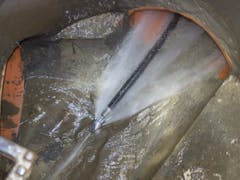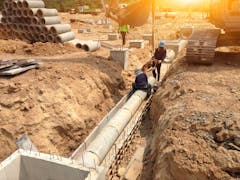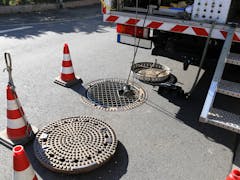Drains R Us
About
- Licenced Plumbers & Drainers
Tree root ingress into sewer lines
Root Growth in Pipes
Roots require oxygen to grow; they do not grow in pipes that are full of water or where high ground water conditions prevail. Roots thrive in the warm, moist, nutrient rich atmosphere above the water surface inside sanitary sewers. The flow of warm water inside the sewer pipe causes water vapour to escape to the cold soil surrounding the pipe. Tree roots are attracted to the water vapour leaving the pipe and they follow the vapour trail to the source of the moisture, which is usually a crack or loose joint in the sewer pipe. Upon reaching the defect, tree roots will penetrate the opening to reach the nutrients and moisture inside.
Problems Caused by Roots Inside Sewers
Once inside the pipe, roots will continue to grow and if not disturbed, they will completely fill the pipe with multiple hair-like root masses at each point of entry. The root mass inside the pipe becomes matted with grease, tissue paper, and other debris discharged from the residence or business. As roots continue to grow, they expand and exert considerable pressure at the crack or joint where they entered the pipe. The force exerted by the root growth can break the pipe and may result in total collapsing of the line. Severe root intrusion in pipes that are structurally damaged will require replacement.
Pipes Susceptible to Root Damage
Some pipe materials are more resistant to root intrusion than others. Clay pipe that was commonly installed by developers and private contractors until the early 1980s is easily penetrated and damaged by tree roots. Clap pipe commonly has a rubber-ring joint at 900mm intervals, giving roots an easy path to enter the sewer line. Concrete pipe and PVC pipe may also allow root intrusions to a lesser extent than clay pipe. PVC pipe is more resistant to root intrusion because it usually has fewer joints. The tightly fitting PVC joints are less likely to leak as a result of settlement of backfill around the pipe.
Root Spread
During drought conditions and in winter, tree roots travel long distances in search of moisture. As a general rule, tree roots will extend up to 2.5 times the height of the tree, and some species of trees may have roots extending five to seven times the height of the tree.
What should I do to control roots in my Sewer?
Once roots are in your pipework they are likely to eventually cause a blockage. The best way to prevent this is to schedule regular cleaning of your sewer. The common method of removing roots from sanitary sewer service pipes involves the use of mechanical cutting, chemical treatment, or high-pressure cleaning. It is also important to keep your sewer structurally sound as any structural fault can allow roots a way into your pipework. You may wish to have a CCTV camera inspection on your sewer line to determine its condition and if any repairs are needed.
Grease build up in sewer lines
We have found that a large number of sewer line blockages are caused by grease. Over time, large quantities of grease flowing through the drain build up on the walls of the pipeline. This deposit can clog the pipe entirely, or collect solid matter to cause a blockage.
How grease blockages are cleared
Mechanical clearing of a drain clogged with grease removes most of the build up. After mechanical clearing of the drain, the wall of the pipe retains some of the grease. To entirely clean the wall of the pipe, a high pressure jetting machine is used to clean the pipeline. This procedure removes all build-up present in the pipeline.
Where the grease comes from
Grease is normally the result of cooking by-products. Grease build up can occur from the following products:
- Meat Fats
- Cooking Oil
- Mayonnaise
- Butter & Margarine
- Sauces
- Food Scraps
- Garbage disposal units, while grinding scraps into smaller pieces, do not prevent grease entering the pipeline.
- Preventing grease entering the drain
It is impossible to stop ALL grease from entering your sewer system, however a few things can be done to minimise it's presence. Empty scraps from plates and cooking items into a refuse bin, or bury under soil. You can use sink strainers to also minimise greasy items entering the drain, empty these into a refuse bin.
Maintaining you grease trap (where applicable)
Never let solids enter your grease trap
Inspect your grease trap on a monthly basis
Check chemicals entering the grease trap are designed to do so. ie. Biodegradable
- Blocked Drain Specialists
- 24 Hour - 7 Day Service
- CCTV Drainage Inspection
- Root Kill Preventative Poisons
- High Pressure Jetting Units
- Pipe Location
·Jetting vehicles that use high pressure water and specially designed nozzles and cutters to clean and flush drains.
·Mechanical machines to clear blocked drains on domestic and commercial properties.
·CCTV camera units to investigate problems in drains.
·Fully equipped and licensed jet machines to chemically foam and treat root infested sewer drains, for domestic and commercial applications.
·24 hour 7 day on call response to blockage problems.
Services
Interested in Drains R Us?
Is this your business?
Verify your listing to gain access to leads, update your profile and add more services and machines.
Verify NowMachines & Services
Services (5)
Locations
- 69 Daisy Road, Manly West QLD 4179, Australia









